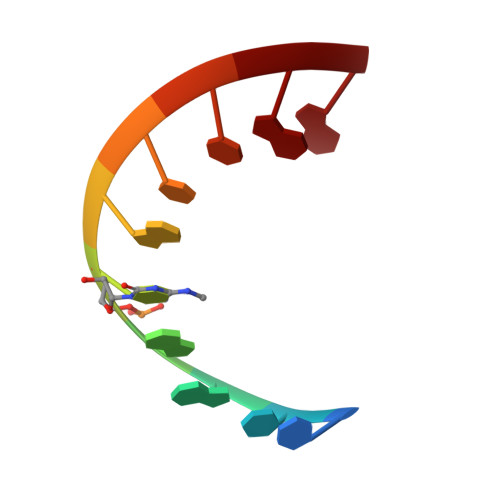Base pairing, structural and functional insights into N4-methylcytidine (m4C) and N4,N4-dimethylcytidine (m42C) modified RNA.
Mao, S., Sekula, B., Ruszkowski, M., Ranganathan, S.V., Haruehanroengra, P., Wu, Y., Shen, F., Sheng, J.(2020) Nucleic Acids Res 48: 10087-10100
- PubMed: 32941619
- DOI: https://doi.org/10.1093/nar/gkaa737
- Primary Citation of Related Structures:
6WY2, 6WY3, 6Z18 - PubMed Abstract:
The N4-methylation of cytidine (m4C and m42C) in RNA plays important roles in both bacterial and eukaryotic cells. In this work, we synthesized a series of m4C and m42C modified RNA oligonucleotides, conducted their base pairing and bioactivity studies, and solved three new crystal structures of the RNA duplexes containing these two modifications. Our thermostability and X-ray crystallography studies, together with the molecular dynamic simulation studies, demonstrated that m4C retains a regular C:G base pairing pattern in RNA duplex and has a relatively small effect on its base pairing stability and specificity. By contrast, the m42C modification disrupts the C:G pair and significantly decreases the duplex stability through a conformational shift of native Watson-Crick pair to a wobble-like pattern with the formation of two hydrogen bonds. This double-methylated m42C also results in the loss of base pairing discrimination between C:G and other mismatched pairs like C:A, C:T and C:C. The biochemical investigation of these two modified residues in the reverse transcription model shows that both mono- or di-methylated cytosine bases could specify the C:T pair and induce the G to T mutation using HIV-1 RT. In the presence of other reverse transcriptases with higher fidelity like AMV-RT, the methylation could either retain the normal nucleotide incorporation or completely inhibit the DNA synthesis. These results indicate the methylation at N4-position of cytidine is a molecular mechanism to fine tune base pairing specificity and affect the coding efficiency and fidelity during gene replication.
Organizational Affiliation:
Department of Chemistry, University at Albany, State University of New York, 1400 Washington Ave. Albany, NY 12222, USA.
















